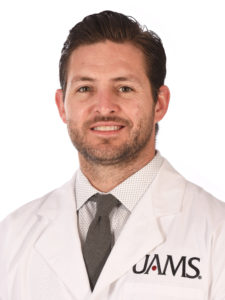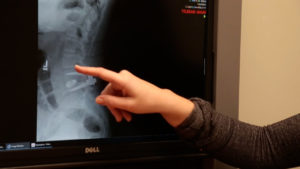Little Rock Woman Walks Out of Hospital Two Hours After Back Surgery
| When Sammie Kaye Rose woke up from her surgery on Jan. 4, she was pleased to find the back pain that kept her movement limited for more than a year was completely gone.
“It was excruciating pain that went from my thigh all the way up to the lower part of my back,” Rose said. “I could not sit in the bathtub, and that’s one of my favorite things to do. I was having a hard time cleaning my house. I’d do a little, and then have to sit down. What usually took me a couple of hours took half a day.”

Sam Overley, M.D., is an orthopaedic surgeon who treats patients at the UAMS Orthopaedic Clinic at Colonel Glenn.
Rose’s primary care provider referred her to physical medicine and rehabilitation physician Antonio Howard, M.D., at the UAMS Physical Medicine and Rehabilitation Clinic. She saw him for about six months when he said it may be time for a conversation with Sam Overley, M.D., at the UAMS Orthopaedic Clinic at Colonel Glenn. Overley is an orthopaedic surgeon who treats a wide variety of spinal conditions including lumbar problems.
“I fell in love with Dr. Overley from my very first visit,” Rose said. “He was very professional and upfront and made sure I understood what he was telling me. But what impressed me the most is that he was willing to FaceTime with my daughter to explain to her what was going on with me.”
Rose needed a spinal fusion surgery to stabilize her vertebra and the disc in between, reducing pain and nerve irritation.
“It’s a common operation you may hear referred to as a TLIF, or transforaminal lumbar interbody fusion,” Overley said. “It’s typically used for people who have some evidence of instability as well as nerve root compression.”

Sammie Rose needed a spinal fusion surgery to stabilize her vertebra and the disc in between.
Overley secured screws and rods to the vertebra and a spacer into the disc space. Then he placed a bone graft into the space. The graft will fuse with the vertebra around it as it heals.
“Usually in cases like Miss Rose, where there is a vertebrae slip and one of the bones is protruding in front of another, I have to reduce it to get it back in place. The surgery took about two hours. Miss Rose was in and out of PACU (post-anesthesia care unit) and walking out of the hospital within the next two hours.”
The surgery normally requires an overnight stay in the hospital. Rose is the first patient at UAMS to go home the same day.

Sammie Rose meets with Sam Overley, M.D., for a checkup following her successful back surgery.
Since Rose’s surgery, Overley has done several more successful outpatient spine surgeries. He also has made some protocol changes to help patients better manage pain at home and says the new protocols have significantly decreased post-surgical pain for patients. The pain management regimen incorporates local anesthetic and uses fewer opioids. Also, patients tend to be more comfortable at home in their own bed and family members can visit freely
“The day of my surgery, I got up in recovery and walked to the bathroom. I went home with a walker, and I’ve been moving around ever since,” Rose said. “It was like a miracle. I went into surgery in excruciating pain. But when I woke up, there was no pain. It may have been attributed to the anesthesia. But even after that wore off, I never had a lot of pain. In fact, I still have over half my pain pills still at home.”
Months after her surgery, Rose is enjoying life, playing with her young grandchildren and staying active.
